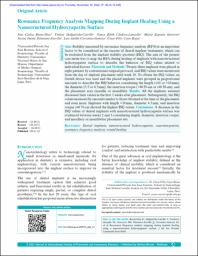Mostrar el registro sencillo del ítem
Resonance Frequency Analysis Mapping During Implant Healing Using a Nanostructured Hydroxyapatite Surface
| dc.contributor.author | Cayo Rojas, César Félix | |
| dc.contributor.author | Rosas-Díaz, José Carlos | |
| dc.contributor.author | Malpartida-Carrillo, Violeta | |
| dc.contributor.author | Córdova-Limaylla, Nancy Edith | |
| dc.contributor.author | Guerrero, Maria Eugenia | |
| dc.contributor.author | Palomino-Zorrilla, Jerson Jimmy | |
| dc.contributor.author | Cervantes-Ganoza, Luis Adolfo | |
| dc.date.accessioned | 2022-11-28T20:03:39Z | |
| dc.date.available | 2022-11-28T20:03:39Z | |
| dc.date.issued | 2022-11-11 | |
| dc.identifier.uri | https://hdl.handle.net/20.500.14308/4234 | |
| dc.description.abstract | Aim: Stability measured by resonance frequency analysis (RFA) is an important factor to be considered in the success of dental implant treatments, which can be evaluated from the implant stability quotient (ISQ). The aim of the present case series was to map the RFA during healing of implants with nanostructured hydroxyapatite surface to describe the behavior of ISQ values related to individual factors. Materials and Methods: Twenty-three implants were placed in eight patients by conventional surgical protocol, and ISQ values were monitored from the day of implant placement until week 20. To obtain the ISQ values, an Osstell device was used and the placed implants were grouped in proportional amounts to describe the ISQ behavior considering the length (≤10 or >10mm), the diameter (3.5 or 4.3mm), the insertion torque (<40 N-cm or ≥40 N-cm), and the placement area (maxilla or mandible). Results: All the implants assessed decreased their values in the first 3 weeks after placement. Subsequently, the ISQ values increased by amounts similar to those obtained at the time of the placement and even more. Implants with length >10mm, diameter 4.3mm, and insertion torque ≥40 N-cm showed the highest ISQ values. Conclusions: A decrease in the ISQ values of dental implants with nanostructured hydroxyapatite surface was evidenced between weeks 2 and 3 considering length, diameter, insertion torque, and maxillary or mandibular placement site. | es_PE |
| dc.description.uri | Trabajo de investigacion | es_PE |
| dc.format | application/pdf | es_PE |
| dc.language.iso | en | es_PE |
| dc.publisher | Journal of International Society of Preventive and Communitary Dentistry | es_PE |
| dc.rights | info:eu-repo/semantics/openAccess | es_PE |
| dc.rights | Attribution-NonCommercial-NoDerivs 3.0 United States | * |
| dc.rights.uri | http://creativecommons.org/licenses/by-nc-nd/3.0/us/ | * |
| dc.source | Universidad Privada San Juan Bautista | es_PE |
| dc.source | Repositorio institucional - UPSJB | es_PE |
| dc.subject | Implantes dentales | es_PE |
| dc.subject | Hidroxiapatita nanoestructurada | es_PE |
| dc.subject | Osteointegración | es_PE |
| dc.subject | Análisis de frecuencia de resonancia | es_PE |
| dc.subject | Cicatrización de heridas | es_PE |
| dc.title | Resonance Frequency Analysis Mapping During Implant Healing Using a Nanostructured Hydroxyapatite Surface | es_PE |
| dc.type | info:eu-repo/semantics/article | es_PE |
| dc.subject.ocde | https://purl.org/pe-repo/ocde/ford#3.02.14 | es_PE |
| dc.publisher.country | IN | es_PE |
| dc.date.embargoEnd | 2022-11-29 | |
| dc.type.version | info:eu-repo/semantics/publishedVersion | es_PE |
| upsjb.especialidad | Estomatología | es_PE |
| upsjb.sede | Chorrillos | es_PE |



